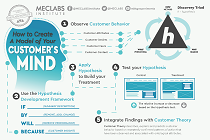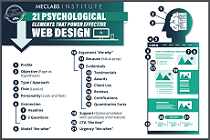
|
SUMMARY:
How do you get your brand to stand out in endless, aimless social media scrolling? Resonate with your ideal customers’ deepest drives – whether that’s saving time, gaining status, or solving a nagging problem. In this article, you’ll learn how to identify those motivations and craft social media messages that speak directly to them. Plus, we include case studies from your peers so you can see examples of these ideas in action. |
Action Box: AI workflow can help do this with you
MeclabsAI can do it with you. Try the multi-agent workflow How to tap into your ideal customer’s motivations with your social media posts (MeclabsAI is MarketingSherpa’s parent company).
Before you post, know who you’re talking to.
Consider demographics (age, location, job title, etc.) and psychographics (e.g., values, interests, pain points).
Also consider behavioral signals. Which social networks do they favor? What types of posts do they engage with most?
When you have a moment with your customers, ask them. Surveys. Quick polls. Even in-person conversations. This is your chance to validate assumptions about your audience. Here’s an example.
The Gary Lanham Group at Coldwell Banker Realty focused on a specific segment and used that deep understanding to drive every piece of social content.
They defined that segment as 55+ homeowners in life transitions:
Creative Sample: Cover image for LinkedIn article

The team uses every listing appointment, client call, or casual neighborhood walk as a form of emotional research. “I keep mental notes, and often run conversations through AI tools like ChatGPT to help identify themes: regret, overwhelm, uncertainty, hope,” explained Gary Lanham, team leader, Gary Lanham Group at Coldwell Banker.
For example, when a 58-year-old widow said, ‘This house is too much for me now,’ Lanham didn’t just hear downsizing – he heard grief, fear, and a longing for peace.
The team builds a three-part story arc to flip one of these emotions into something constructive:
“I record two versions of the message,” Lanham said. “A short [Instagram and Facebook] Reel or YouTube Short (30–60 seconds) to grab attention. A longer video (2–3 minutes) that offers real substance.”
The team tracks metrics like views, but numbers alone don’t show emotional impact, so they also keep a close eye on comments and private messages. “I recently had a woman reach out after watching one of my Shorts. She said: ‘Gary, I saw myself in that video. You weren’t selling to me. You were speaking with me.’”
If a post isn’t doing well, the team reviews:
“If it’s off, I’ll recut the opening or repackage the message into a different format – maybe a quote card, a carousel post, or a voiceover Short,” he said.
The team’s platform strategy has evolved over time. “We started on Facebook and Instagram and still use them consistently. They’re familiar, especially to older homeowners. But this past year, we’ve gone ‘all in’ on YouTube and LinkedIn,” Lanham said. “YouTube is owned by Google, so every video helps improve my search engine ranking.”
On LinkedIn, the team connects with high-net-worth sellers, attorneys, and professionals who value depth. Lanham used this analogy: “If Facebook is the neighborhood porch, YouTube is the open house, and LinkedIn is the boardroom.”
While I try to outline MarketingSherpa how-to articles into well-defined steps to help give you a clear roadmap – in practice, these steps can bleed together and aren’t always clearly delineated. And that’s the case with Step #2 – it goes hand-in-hand with the first step in this article.
But you can think of the first step as the ‘who’ and now this step gets into the ‘why.’
What are your ICP’s drivers? For example, you could break down their drivers by what they move towards, and what they move away from. That’s the way MeclabsAI (the parent company of MarketingSherpa) approaches these core motivations.
For ‘move towards,’ you’re asking – ‘What positive outcome do they crave?’ It could be faster processes or professional recognition.
And also consider what they move away from. What risk or pain do they want to avoid? For example, wasting budget on poor solutions or avoiding a public failure.
You can review customer support tickets or online reviews. Highlight words and phrases that reveal these drivers. Or you can use sentiment analysis, like in our next case study.
You want to listen to what customers say – positive, negative, and neutral – to reveal their true drivers and pain points before you craft any messaging. In other words, read the room before you grab the mic.
The team at Brand24 conducted sentiment analysis across different social media platforms for an electric vehicle brand. Forum monitoring and social media sentiment analysis deliver unfiltered insights into what the customer is thinking, feeling, and experiencing.
Creative Sample: Top discussion topics per social media platform (sample data)

“Reddit and Twitter surfaced as early detectors of user frustration, while YouTube reviews and forums held more sustained brand impressions (positive or negative),” said Wojciech Chrzan, head of insights, Brand24.
The team analyzed which topics caused sentiment drops per platform and how they spread. For example, spikes in negative mentions linked with phrases like ‘waiting hours’ or ‘update failed’ helped pinpoint software or support as bottlenecks.
One of the most viral social media mentions concerned an update that caused user interface lags. It went unaddressed for four days, resulting in sentiment deterioration across communities.
These insights led the team to:
These changes helped lead to a 19% increase in positive sentiment around the brand’s software and support, and 25% growth in high-reach positive mentions.
“If you understand your audience's moods and needs well, you can respond to them effectively. Is it really that simple? Yes, although it's not easy to implement. Trust the data and try to identify issues that you can address,” Chrzan advised.
That was a B2C example, so let’s now take a look at a B2B example.
PAN describes itself as a midsize global B2B integrated marketing agency. Yet the team sees its ideal customer as real, three-dimensional humans…not B2B automatons.
They want to understand things like – How does their ideal customer spend their time outside of the office? What are their habits? Do they like sports? Gossip? “We ask these questions first, and then look at sites like Reddit, Substack, and Medium to see what people are saying when no one is actively looking,” said Becky Fox, social media manager, PAN.
The team monitors their work-related interests as well. “Are they asking for help because their brand is no longer on the top page of Google results thanks to AI overviews?” she mentions as an example.
By clicking into profiles on social media platforms like Reddit and Substack they can get this complete picture of their ideal customer by seeing everything they commented or posted.
For example, they saw many ideal prospects interested in executive social media. So the social team fed that to to the content manager, who wrote a blog post about it. “We then created a carousel post on LinkedIn, highlighting the main points of the blog, and posted it to the brand page,” Fox said.
Creative Sample: LinkedIn post

Now that you know your prospects’ ‘why,’ tailor your posts.
Use headlines that hook into their main pain points or goals, visuals that reinforce the value you’re delivering, and calls to action that serve your ideal prospect.
You could focus the content on the ‘moves towards’ (for example, a post with a time-saving checklist would have positive appeal) or ‘moves away from’ (for example, a post that helps them avoid common pitfalls is anxiety alleviation).
Humans move towards a lot of thing in life and business. We’re fans of classic cars and homemade pasta at work, or specific programming languages or types of boots at work. I thought this next case study would be a great example of tapping into what people ‘moves towards,’ because it’s from the industry most known to use the word ‘fans’ – sports.
One of the more successful social media campaigns the team at Dugout Mugs runs annually is called Signature September. “In this campaign, I have some of my colleagues from major league baseball autograph a bunch of items,” explained Kris Dehnert, Owner/CEO & cleanup hitter, Dugout Mugs.
They promote the giveaway on social media with an SMS keyword campaign.
Creative Sample: SMS keyword sign-up sweepstakes shared on social media

When fans opt-in, they receive an automated reply with a one-time, 40%-off offer. If you think that is an overly generous, margin-killing discount, consider this…would you be spending that money on paid ads anyway? “It is pretty common these days to spend upwards of 50% anyway, just to acquire the customer in the first place on traditional Google/Meta advertising,” Dehnert said.
When they factor in all of the pieces that made the campaign possible – the autographed items, the cost of managing the list, the cost of the employees, sending the campaigns – they hit their goal CPA of under three dollars.
People trust peers more than brands. So some of the most effective posts you ever have may be simply reposting what satisfied customers say about you online.
However, you can’t just rely on the kindness of others to post. Not if you’re a professional marketer or entrepreneur with a social media editorial calendar. So here are some tactics you can leverage in posts from your brand:
Few companies are better positioned than TrustRadius to leverage social proof – it is a review site, after all.
But before I show you an example of that, I want you to consider how they address ‘Step #3: Align content with motivations.’ While it’s important to align your content with your ideal prospects’ motivations, consider the motivations of the platforms you’re using as well.
For example, the team at TrustRadius realized that LinkedIn wanted to keep people on its platform. And they believed its 2023 algorithm update shifted emphasis to niche engagement over follower count. “Hootsuite and LinkedIn research confirmed that consistent, high-engagement posts from a targeted follower base would improve reach,” said Allyson Havener, Chief Marketing Officer, TrustRadius.
They put a heavy emphasis on polls, carousels, and persona-driven content to increase interaction, while keeping people on LinkedIn's platform – to serve the motivations of both their ideal prospect and the social media platform.
The team posts twice per weekday and once per weekend day. “Consistent weekday and weekend scheduling, combined with the use of our social management tool calendar and GaggleAMP for advocacy, helped us maintain frequency and engagement over time,” she said.
On Sundays, their weekend day post is a great example of social proof…but they put their ideal prospects first with the post by sharing social proof for their prospects instead of social proof for their own brand. The great thing about this strategy is their brand shines as well by showing (not just telling) the value they can bring to these prospects. They don’t have to brag (about themselves), they just have to show the value they add.
They called these posts #ShoutOutSunday. Each post @ mentions an ideal prospect company that received reviews on TrustRadius, includes the company’s overall score, an image of a review, and a link to more reviews about the company on TrustRadius.
Creative Sample: #ShoutOutSunday LinkedIn post

“TrustRadius achieved a 28% YoY follower growth on LinkedIn – highest among its competitors – and a 26.24% engagement rate per follower in a 90-day span, which outperformed G2, Capterra, and Gartner,” Havener claimed.
Even the best hypothesis needs validation. For example, you might test whether a move-toward gain or a move-away-from pain message works better for your ideal customer (there’s a nice example of a LinkedIn test aimed at lawyers in Marketing Promotion Strategies: These 3 message levers moved people to click, link, and refer).
While some social media platforms offer split testing – like A/B content testing in Meta Business Suite – even if you can’t run a statistically valid split test you can still try different messages sequentially and see what you learn about your audience.
"One of our most impactful A/B tests was on Instagram Reels when promoting our patented palm leaf straws," said Pallavi Pande, Founder & CEO, Dtocs.
The team discovered that customers connected more deeply when they saw the product in a real-world context, especially tied to an aspirational event. They shifted their content strategy to feature more 'in-use' storytelling instead of studio product shots.
The team at DomiSource is constantly monitoring audience behavior to tap into their motivations. “[We use] social media analytics – Sprout Social – to track engagement, reach, and click-through rates. [We also use] hashtag analytics – platforms like Hashtagify.me and RiteTag – to identify a mix of high-reach and niche hashtags and expand our niche,” explained Karen Watts, founder, DomiSource.
Once they have some ideas about their audience’s motivations, they test to discover what works best.
“TikTok’s format allows DomiSource to engage in quick, iterative testing of content – publishing multiple variations of posts with different hooks, visuals, and tones,” Watts said.
For example, in videos aimed at Clemson students, the team tested a straightforward packing checklist video versus a more engaging video that used local insights (where to shop for dorm essentials, best local food spots near Clemson).
This testing ultimately feeds into ideas for the team’s content calendar (see next step).
Depending on your product of service, your ideal customer’s motivations may change with the calendar. For example, if your company is an HVAC service, you might want to post about maintenance in late spring but focus on repairs in the dog days of August.
Aside from tapping into seasonal motivations, a content calendar helps your brand publish consistently. A reliable presence on the social media platforms your ideal customer is motivated to use helps build trust. If you just randomly post and are not consistent, why should your prospects believe that you will consistently support them if they become customers.
To give you ideas for what to include in your own content calendar, here’s an example.
For the DomiSource team mentioned in Step #5, they organize their content calendar by weeks.
Creative Sample: Screenshot of DomiSource content calendar

Each week includes the following info:
Most of these categories could be used by any brand, but the checklist category is an example of how the team plans all of its content around key value they provide to their audience – a moving checklist.
In the case of DomiSource, their College Move-In Checklist Survey initiative allowed the team to discover and tap into the real challenges faced by students and parents.
Creative Sample: Instagram post for college move-in checklist survey

The feedback directly influenced the improvements the company has made to its services, but also ensured that its social media posts address the most pressing pain points.
“A Stanley cooler giveaway incentivized participation, tapping into the audience’s desire for rewards and recognition,” Watts said.
Apply to get 1 of 10 AI Engineering vouchers ($5,000 value) to turn your knowledge and processes into a new revenue stream. Learn eligibility requirements and apply at Meclabs.com/5kVoucher
How to use social media to increase your marketing conversion
How to create offers customers can't resist (without discounting)
Get Better Business Results With a Skillfully Applied Customer-first Marketing Strategy

The customer-first approach of MarketingSherpa’s agency services can help you build the most effective strategy to serve customers and improve results, and then implement it across every customer touchpoint.
Get More Info >MECLABS AI

Get headlines, value prop, competitive analysis, and more.
Use the AI for FREE (for now) >Marketer Vs Machine

Marketer Vs Machine: We need to train the marketer to train the machine.
Watch Now >Live, Interactive Event

Join Flint McGlaughlin for Design Your Offer on May 22nd at 1 pm ET. You’ll learn proven strategies that drive real business results.
Get Your Scholarship >Free Marketing Course

Become a Marketer-Philosopher: Create and optimize high-converting webpages (with this free online marketing course)
See Course >Project and Ideas Pitch Template

A free template to help you win approval for your proposed projects and campaigns
Get the Template >Six Quick CTA checklists

These CTA checklists are specifically designed for your team — something practical to hold up against your CTAs to help the time-pressed marketer quickly consider the customer psychology of your “asks” and how you can improve them.
Get the Checklists >Infographic: How to Create a Model of Your Customer’s Mind

You need a repeatable methodology focused on building your organization’s customer wisdom throughout your campaigns and websites. This infographic can get you started.
Get the Infographic >Infographic: 21 Psychological Elements that Power Effective Web Design

To build an effective page from scratch, you need to begin with the psychology of your customer. This infographic can get you started.
Get the Infographic >Receive the latest case studies and data on email, lead gen, and social media along with MarketingSherpa updates and promotions.